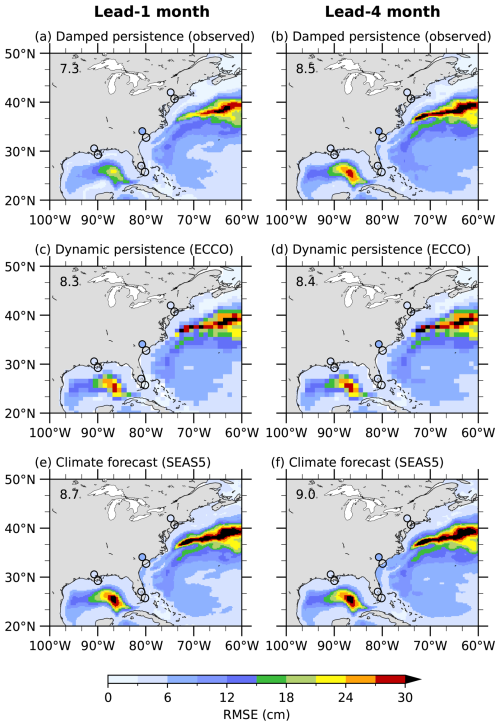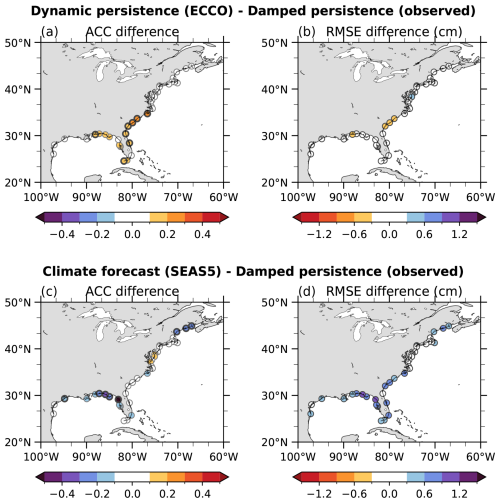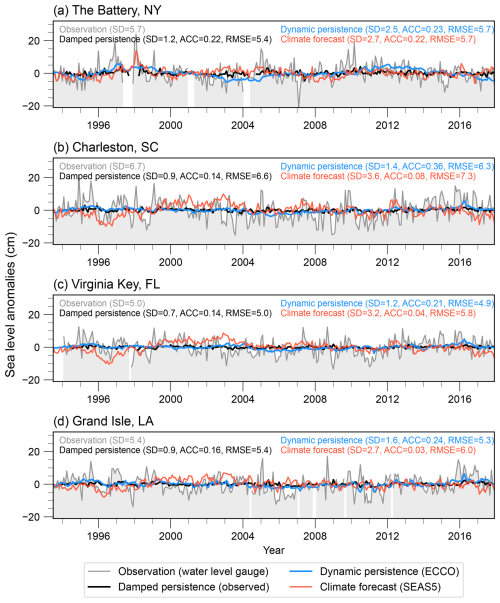the Creative Commons Attribution 4.0 License.
the Creative Commons Attribution 4.0 License.
Indications of improved seasonal sea level forecasts for the United States Gulf Coast and East Coast using ocean dynamic persistence
Xue Feng
Matthew J. Widlansky
Magdalena A. Balmaseda
Gregory Dusek
William Sweet
Malte F. Stuecker
Forecasting seasonal sea levels along many coasts remains challenging, with generally lower skills than forecasts for the open oceans. We investigate the influence of ocean dynamics on forecasting monthly sea level anomalies for the United States Gulf Coast and East Coast using the Estimating Circulation and Climate of the Ocean (ECCO) system, which is initialized monthly from 1992 through 2017 and runs forward for 12 months under climatological atmospheric forcing. This approach, which we refer to as an ocean dynamic persistence forecast, demonstrates improved skill compared to both observed damped persistence and the ECMWF SEAS5 climate forecast system when evaluated against observations. At a lead of 4 months, dynamic persistence has the highest anomaly correlation coefficients at 22 out of 39 coastal locations (mostly south of Cape Hatteras). However, improvement in root mean square error is minimal, possibly due to reduced variability in ECCO associated with its climatology forcing and coarse resolution. This study suggests that dynamic persistence offers the potential to improve sea level forecasts beyond the capabilities of damped persistence and a state-of-the-art climate model.
- Article
(10033 KB) - Full-text XML
- BibTeX
- EndNote
Forecasting monthly changes in coastal sea levels is challenging, especially along the United States (US) Gulf Coast and East Coast, where climate models have yet to demonstrate skill at seasonal lead times (Long et al., 2021, 2025). In the open ocean, using global climate models to forecast sea level variability has shown promising results (Widlansky et al., 2023; Balmaseda et al., 2024), particularly in the tropical Pacific where predictions of monthly sea level anomalies are routinely provided to island communities in the form of enhanced high-tide outlooks (Widlansky et al., 2017). Climate models such as the fifth-generation Seasonal Forecasting System (SEAS5) from the European Centre for Medium-Range Weather Forecasts (ECMWF) are also skillful for sea surface height (SSH) variability in much of the tropical and subtropical Atlantic Ocean (Balmaseda et al., 2024), although no sea level prediction products utilizing this skill in the open-ocean Atlantic have been developed for the coastal US.
The main reason why climate model forecasts of SSH in the Atlantic Ocean are not used to improve seasonal predictions of high-tide flooding, such as NOAA's monthly outlook, is because the state-of-the-art forecast models are not skillful at Gulf Coast and East Coast water level gauge locations (Long et al., 2021; Widlansky et al., 2023; Balmaseda et al., 2024). Consider Charleston, South Carolina, where the anomaly correlation coefficient (ACC) at seasonal lead times (e.g., the outlook 4 months in the future, which we call the lead-4 month forecast) is nearly zero if utilizing SSH from SEAS5 or any other climate model so far assessed (Long et al., 2025). For coastal sea levels at such locations, seasonal forecast skill is perhaps limited by inaccurate initializations of the climate models (Widlansky et al., 2023; Feng et al., 2024), simulation biases in the coupled atmosphere–ocean system (Meehl et al., 2021; Roberts et al., 2021), and low predictability of the wind stress anomalies (Newman et al., 2003; Obarein et al., 2023).
Since climate models have yet to demonstrate skillful seasonal sea level forecasts for the Gulf Coast and East Coast, NOAA currently relies on statistical forecasts of the monthly anomalies (i.e., the autocorrelation damping timescale of water level observations; referred to as a damped persistence forecast), combined with long-term trends and tide predictions, to provide information for their monthly high-tide outlooks (Dusek et al., 2022). Unfortunately, including damped persistence in the NOAA outlook minimally increases skill beyond a climatology-only model for most locations on the Gulf Coast and East Coast because the statistical persistence of monthly sea level anomalies dampens to nearly zero by the lead-4 month, especially between Key West, Florida, and Cape Hatteras, North Carolina, where the autocorrelation decay is fastest (Dusek et al., 2022).
The apparent lack of skillful seasonal sea level forecasts for the Gulf Coast and East Coast contrasts with what we could expect based on the relatively slowly evolving ocean, which provides sources of predictability on seasonal and longer timescales (e.g., Hasselmann, 1976; Deser et al., 2003). The persistence of oceanic conditions, due to the ocean's high inertia of thermal and momentum energy, or so-called ocean memory (e.g., Frankignoul and Hasselmann, 1977; Shi et al., 2022), allows sea level anomalies to be tracked in the open ocean for months (e.g., Chelton and Schlax, 1996). Slow ocean dynamics, such as westward-propagating Rossby waves, sometimes carry sea level anomalies across the Atlantic, which project onto the coastal sea level variability, especially south of Cape Hatteras (Minobe et al., 2017; Calafat et al., 2018; Dangendorf et al., 2023; Wang et al., 2024). In addition, remote buoyancy forcing from high latitudes could influence sea levels along the East Coast through oceanic advections and coastal-trapped waves (Frederikse et al., 2017; Wang et al., 2022; Zhu et al., 2024). Considering these well-established physical processes and the availability of reliable initial conditions in this region from ocean reanalyses (Feng et al., 2024), it may be possible to achieve more skillful seasonal sea level forecasts for the East Coast. However, certain aspects of the coastal environment, such as the highly variable nature of nearshore winds (Lee et al., 2023), are likely to complicate efforts to skillfully forecast the sea level variability, as these winds can disrupt otherwise predictable oceanic conditions and influence local sea level responses.
One opportunity for improving sea level forecasts is to isolate oceanic information from atmospheric variability, the latter of which is much less predictable at leads beyond a couple of weeks (e.g., Hasselmann, 1976; Newman et al., 2003), then let the ocean evolve according to its internal dynamics. Using an adjoint sensitivity analysis derived from the Estimating Circulation and Climate of the Ocean (ECCO) model, Frederikse et al. (2022) evaluated a hybrid dynamical forecasting method consisting of atmospheric forcing from either a climate model forecast (CCSM4) participating in the North American Multi-Model Ensemble or the mean annual cycle (i.e., climatology). They referred to the latter forcing approach as “ocean dynamic persistence” and applied it to forecasting sea levels at one pilot location on the Southeast Coast (Charleston). At the lead-4 month, their study showed that both sets of retrospective forecasts had higher ACC values (and lower root mean square error; RMSE) than the damped persistence forecast at the Charleston water level gauge, with the dynamic persistence approach performing best (see their Fig. 6).
Given the promising result at Charleston in Frederikse et al. (2022), we aim to test the opportunity for expanding improvement to other parts of the Gulf Coast and East Coast using the dynamic persistence approach. Different from Frederikse et al. (2022), where the sea level forecasts rely on a pre-computed sea level sensitivity to atmospheric forcing to represent ocean dynamical responses, our investigation utilizes a set of retrospective forecasts produced with an initialized version of the ECCO model that runs forward for 12 months under climatological atmospheric conditions. This configuration allows us to evaluate the potential of ocean dynamic persistence in forecasting sea level anomalies everywhere along the coast at the model's resolution (details about the model and forecasting method are described in Sect. 2). We will compare the performance of the ECCO dynamic persistence model with that of the observed damped persistence of sea levels as well as the SSH forecast from the SEAS5 climate model. Through this assessment, we seek to address current limitations in skillfully forecasting coastal sea levels by exploring the potential of ocean dynamic persistence.
This study utilizes sea level observations from NOAA's National Water Level Observation Network as well as various satellite altimetry missions to assess the performance of different seasonal forecasting methods. For water level gauges, we obtained hourly sea level data from NOAA's Center for Operational Oceanographic Products and Services (CO-OPS) for 39 stations along the Gulf Coast and East Coast (Fig. 1), consistent with the locations used in Feng et al. (2024) to assess coastal sea level variability in ocean reanalyses. The hourly time series are averaged to daily data after removing the tide components with the Unified Tidal Analysis and Prediction functions in MATLAB (UTide). Since the present study focuses on the dynamic sea level forecast, the local inverse barometer (IB) effect is removed from the observations using sea level pressures from the ERA5 reanalysis (Hersbach et al., 2023). For altimetry, we obtained gridded absolute dynamic topography level 4 data from the Copernicus Marine and Environment Monitoring Service (CMEMS), which have a spatial resolution of 0.25°×0.25° and daily temporal resolution. A dynamic atmospheric correction has been applied to the CMEMS product so that there is no IB effect. We performed monthly averaging of both observations (i.e., the daily water levels and altimetry). These monthly sea level observations cover the overlapping period of the retrospective forecasts assessed here, which begin in 1993.
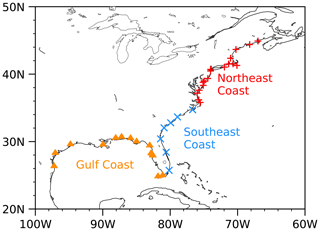
Figure 1Study domain and water level gauge locations. The Northeast Coast extends from Eastport, ME (8410140), to Oregon Inlet Marina, NC (8652587); the Southeast Coast extends from Beaufort, NC (8656483) to Virginia Key, FL (8723214); and the Gulf Coast extends from Vaca Key, FL (8723970), to Port Isabel, TX (8779770). The seven-digit numbers following the location names denote the NOAA station IDs of the water level gauges.
Observations from water level gauges and altimetry are used in the damped persistence forecasts assessed here. In the damped persistence model, each forecast is generated using the previous month's observations to predict the target month's sea level anomalies. The damping timescale is determined from the observed rate of how sea level anomalies decay to zero. We refer to the prediction for the month after the observation as the lead-1 month forecast. Note that the dynamical models considered here are initialized on the first day of each month, and we refer to the mean output during the first month of simulation as the lead-1 month forecast.
The dynamic persistence forecasts are generated by NASA's Jet Propulsion Laboratory (JPL) using the ECCO system. The initial conditions of the forecast are derived from the observation-constrained ocean state estimate from ECCO Version 4 Release 4 (ECCO V4r4; Forget et al., 2015), which is based on the global MITgcm with a 1° nominal resolution. The ocean state estimate is obtained by optimizing a set of control variables (surface forcing, mixing parameters, and initial state) in an iterative process such that the forward model solution is consistent with a diverse set of satellite and in situ ocean observations within the uncertainty estimates of the observations (Forget et al., 2015). Despite its coarse resolution, ECCO V4r4 can reasonably reproduce coastal sea level variability (Fig. 2). Along the Southeast Coast and Gulf Coast, ECCO V4r4 shows comparable ACC and RMSE to eddy-permitting ocean reanalyses such as ECMWF's Ocean ReAnalysis System 5 (ORAS5; Zuo et al., 2019). The atmospheric state variables from the ECCO optimization are used to force the ocean model, with surface fluxes of heat, momentum (wind stress), and fresh water being computed externally. For each month from January 1992 to December 2017, the model is integrated forward in time for 12 months with monthly climatological forcing to generate a set of 12-month forecasts. This flux-forced model configuration allows us to isolate the effect of ocean dynamics on the seasonal sea level forecast, while excluding the potential biased atmosphere forecast and ocean–atmosphere interactions. Because these forward simulations use climatological seasonal forcing, any interannual variations or monthly anomalies in the retrospective forecasts are due to the evolution of the initial ocean state. Note that the dynamic persistence forecast is not an ensemble forecast, meaning that there is a single forecast for each target month at a specific lead time. We assessed the monthly dynamic sea level output, which does not include the IB effect.
The Operational Seasonal Forecast System (SEAS5) at ECMWF is a fully coupled global climate model utilizing the NEMO ocean component with a nominal horizontal resolution of 0.25° (Johnson et al., 2019). This model was initialized monthly from January 1993 to December 2023 using ORAS5. For forecasts initialized in February, May, August, and November, SEAS5 provides a 13-month outlook with 15 ensemble members, while forecasts from other months have a 7-month outlook with 25 ensemble members. We evaluate the ensemble mean forecast for the period overlapping the ECCO dynamic persistence model (i.e., 1993–2017), although the SEAS5 assessment is focused on when forecasts are available from all 12 start months (i.e., lead times out to 7 months). SEAS5 excludes the IB effect.
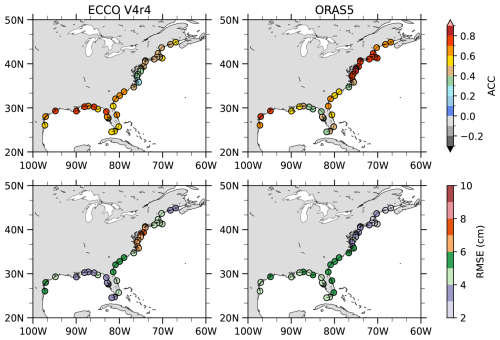
Figure 2ACC and RMSE of monthly sea level anomalies from the ECCO state estimate and ORAS5 with water level gauge observations. The ORAS5 assessment is modified from Feng et al. (2024).
We evaluated the seasonal forecast skills of the damped persistence (observed), dynamic persistence (ECCO), and climate forecast (SEAS5) models by comparing their monthly sea level anomalies, nearest to the locations of water level gauges, against such observations as well as altimetry interpolated to the model grids. To correct for biases caused by model drift (see Widlansky et al., 2017; Long et al., 2021), the sea level anomaly forecasts from ECCO and SEAS5 were calculated by removing the lead-time-dependent monthly climatology of the retrospective epoch common to the forecast models (i.e., 1993–2017). Linear trends for that period were also removed from each forecast, which follows established methods for avoiding the influence of long-term changes on seasonal forecast skills (e.g., Widlansky et al., 2017; Long et al., 2021; Balmaseda et al., 2024; Long et al., 2025). Observed sea level anomalies were calculated relative to climatology based on the 1993–2017 period, with the trend removed accordingly. Metrics of assessment include standard deviation (SD), ACC, and RMSE, which are presented for each model as well as relative to the performance of the damped persistence model. For the latter comparison, we tested the significance of ACC differences at each location using Fisher's z-transformation method. We calculated the z statistic based on the difference between the two transformed z scores, and a two-tailed test at the 0.05 significance level was applied against the null hypothesis that both models have similar skill. The sample size was set to 294, which is the number of target months available for each forecast lead time.
Seasonal forecasting skill according to the ACC metric is shown in Fig. 3 across the three models: damped persistence (observed), dynamic persistence (ECCO), and climate forecast (SEAS5). The sea level anomalies at lead-1 and lead-4 months were evaluated against observations from water level gauges and satellite altimetry. Results for locations of The Battery (New York; NY), Charleston (South Carolina; SC), Virginia Key (Florida; FL), and Grand Isle (Louisiana; LA) are shown to provide examples of the sea level forecast verification for the respective parts of the coastal US (i.e., in the Northeast Coast, Southeast Coast, and Gulf Coast; Fig. 1).
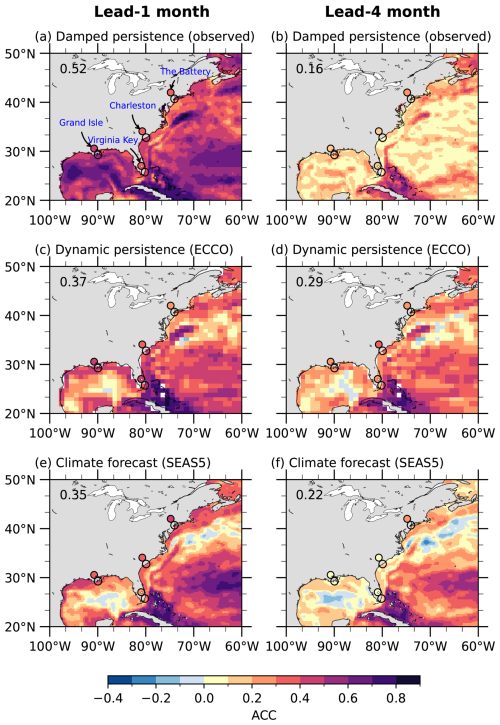
Figure 3Retrospective forecast skill (ACC) at lead-1 and lead-4 months for the damped persistence (observed; a and b), dynamic persistence (ECCO; c and d), and climate forecast (SEAS5; e and f) models. Forecasts of monthly sea level anomalies are compared to observations by altimetry (shading) and water level gauges (colored circles on land) at four example locations (indicated by unfilled circles on the coastline). The domain-averaged ACC is shown in the upper left of each panel.
At the lead-1 month, damped persistence (using altimetry) demonstrates fairly high ACC throughout most open-ocean areas of the northwestern Atlantic and Gulf Coast regions (i.e., ACC values exceed 0.5 almost everywhere); however, ACC values are lower along the coast (Fig. 3a). For example, the ACC of damped persistence (using water level gauges) is 0.32 at The Battery, 0.40 at Charleston, 0.39 at Virginia Key, and 0.44 at Grand Isle. There are also some offshore areas of relatively lower ACC values (and higher RMSE; Fig. 4), where the monthly sea level variability is much greater than at the coast (see Fig. 1 in Long et al., 2021).
Dynamic persistence exhibits similar ACC values compared to damped persistence of altimetry and water level gauges at lead-1 month for the coastal examples; however, skill is somewhat lower in most of the open ocean (Fig. 3c). The Loop Current region of the interior gulf and where the Gulf Stream extends away from the coast (i.e., at about 35° N in the Atlantic Ocean) are notable examples of where dynamic persistence ACC values are much lower than damped persistence at the lead-1 month. The RMSE metric mostly mirrors this result (i.e., higher errors in these energetic offshore areas; Fig. 4). In most other areas of the open ocean, ACC values are higher and RMSE is lower for all models relative to within the Loop Current/Gulf Stream system, although the overall skill at the lead-1 month for dynamic persistence is worse than damped persistence nearly everywhere (considering the domain-averaged values listed in Figs. 3 and 4).
The climate forecast model has similar overall ACC values at the lead-1 month (Fig. 3e) to dynamic persistence (Fig. 3c). Retrospective forecasts from both models exhibit relatively low ACC values in the Loop Current region and the Gulf Stream extension (i.e., offshore of Cape Hatteras), especially compared to damped persistence (Fig. 3a). The climate forecast performs particularly well for a broad area of the subtropical Atlantic Ocean, where its ACC values equal or beat dynamic persistence. The RMSE metric again mirrors the ACC result for the climate forecast (Fig. 4). For the coastal locations, at the lead-1 month, ACC and RMSE values are similar among the three retrospective forecasts.
By the lead-4 month, each model shows less forecast skill according to the ACC metric, both along the coast and in most offshore areas (Fig. 3b, d and f). The decline in skill compared to the lead-1 month forecasts is greatest for the damped persistence model. In particular, the domain-averaged ACC for damped persistence has declined from 0.52 at the lead-1 month to 0.16 at the lead-4 month. Along the coast, there is no evidence of damped persistence having much skill at the lead-4 month, as the ACC is only 0.22 at The Battery, 0.14 at both Charleston and Virginia Key, and 0.16 at Grand Isle. In the offshore regions, ACC values are also generally less than 0.2, except for a region of noticeably higher values around Cuba and the Bahamas. RMSE is also low in the coastal regions, and the changes from lead-1 to lead-4 month are small (Fig. 4).
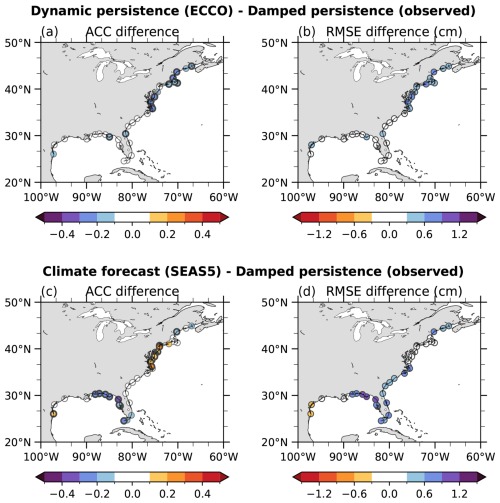
Figure 5Differences of retrospective forecast skill (ACC and RMSE) at the lead-1 month for the dynamic persistence (ECCO; a and b) and climate forecast (SEAS5; c and d) models compared to damped persistence of monthly sea level anomaly observations by water level gauges (colored circles). Skill of the damped persistence model is subtracted from that of the other models at each location. Orange shading indicates more skill (higher ACC and lower RMSE) compared to the damped persistence model. Circles with thick black outlines denote statistically significant ACC differences at the 0.05 significance level.
Dynamic persistence is the best-performing model at the lead-4 month, according to the ACC metric, particularly along the coast (Fig. 3d). Consider the forecasts at Charleston where the lead-4 month ACC value for dynamic persistence is 0.36, compared to only 0.14 and 0.08 for damped persistence and the climate forecast, respectively. However, RMSE assessments at the lead-4 month show only modest improvements for dynamic persistence compared to the other models (e.g., at Charleston, the RMSE is 6.3 cm for dynamic persistence, which is not much better than the 6.6 cm for damped persistence and 7.3 cm for SEAS5; Fig. 4). Notably, the climate forecast has lower ACC values along the coast at this lead (Fig. 3f) compared to dynamic persistence, although the offshore performance of the former equals or beats the other models.
Using damped persistence as a benchmark of seasonal forecasting skill (or lack thereof), Figs. 5 and 6 show lead-1 and lead-4 month ACC and RMSE differences, respectively, for the dynamic persistence and climate forecast models. At the lead-1 month, dynamic persistence performs worse than damped persistence along the Northeast Coast, while no significant differences are found along the Southeast Coast and Gulf Coast (Fig. 5a and b). However, by the lead-4 month, the dynamic persistence model has better forecast skill, with significantly higher ACC compared to damped persistence for most locations along the Southeast Coast (Fig. 6a). The region with higher ACC for the dynamic persistence model extends to the northeastern Gulf Coast, though the difference there is not statistically significant. However, the spatial pattern of skill differences shows regional coherence, suggesting widespread skill improvements south of Cape Hatteras in the dynamic persistence model, even if not passing a significance test at each specific location. Elsewhere along the coast (i.e., in the northeast and western Gulf Coast), the lead-4 month forecast performance is similar between dynamic persistence and damped persistence. According to the RMSE metric, skill differences between these models at the lead-4 month are minor nearly everywhere (i.e., differences of less than 1 cm; Fig. 6b).
The climate forecast model demonstrates utility shortly after its initialization at The Battery and several neighboring locations in the northeast, with significantly higher ACC than damped persistence at the lead-1 month (Fig. 5c and d). However, even at that early lead time, its performance is worse than damped persistence along the northeastern Gulf Coast according to the ACC and RMSE metrics, as well as the Southeast Coast according to only RMSE. At the lead-4 month, there is no widespread evidence that the climate forecast performs better than the other models along the Northeast Coast or along the Gulf Coast and Southeast Coast (i.e., its ACC and RMSE values are similar to or worse than damped persistence at almost all coastal locations considered here, although the climate forecast has slightly higher ACC at three locations in the Chesapeake Bay area to the north of Cape Hatteras; Fig. 6c and d).
Changes in forecast skill as a function of lead time are shown in Fig. 7 at the example locations for each of the models (the climate forecast ends at the lead-7 month, whereas damped persistence and dynamic persistence extend another 5 months). According to the ACC and RMSE metrics, the climate forecast performs best at only one location (The Battery), but only for the first month (Fig. 7a and b). The climate forecast skill decays faster than the other models at all four locations (i.e., the ACC decreases and the RMSE increases). Whereas the skill at the lead-1 month for dynamic persistence is like the climate forecast (and damped persistence), the dynamic persistence skill has a slower decay with increasing lead, especially according to the ACC metric (its RMSE worsens at a similar rate as damped persistence). Based on ACC values, dynamic persistence becomes the best-performing model by the lead-5 month at The Battery (Fig. 7a), the lead-2 month at Charleston (Fig. 7c) as well as Virginia Key (Fig. 7e), and the lead-3 month at Grand Isle (Fig. 7g), with damped persistence being the similar- or better-performing model at earlier leads. RMSE values are similar for damped persistence and dynamic persistence, with both models generally having smaller errors than the climate forecast (Fig. 7b, d, f, and h).
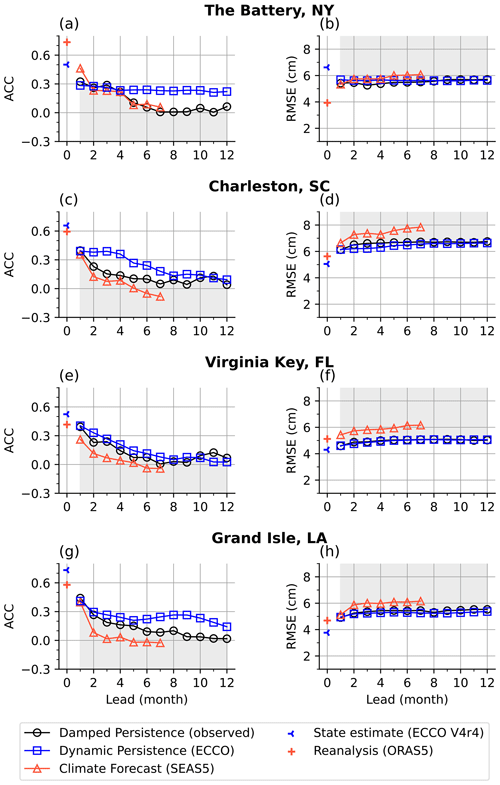
Figure 7Retrospective forecast skill (ACC and RMSE) as a function of lead time at four example locations (labeled in Fig. 1a). Markers (see legend) correspond to the damped persistence (observed), dynamic persistence (ECCO), and climate forecast (SEAS5) models. Also shown are the state estimate (ECCO V4r4) and reanalysis (ORAS5), which are the initial conditions corresponding to the latter two forecasts. Monthly sea level anomalies from each product are compared to observations by water level gauges. Gray shading designates less skill than the damped persistence model at a particular lead month (lower ACC and higher RMSE).
Differences in initial conditions seem to be associated with forecast skill variations between the dynamic persistence and climate forecast models, at least at the earliest lead time. Model initial conditions are from the ECCO state estimate for dynamic persistence and ORAS5 for the climate forecast (ACC and RMSE metrics for the respective state estimate and reanalysis are marked at the lead-0 month in Fig. 7). At the lead-1 month, there is evidence of the model with higher forecast skill at a particular location also having the better initial condition for that area (e.g., at The Battery where ORAS5 and SEAS5 perform better than the ECCO state estimate and dynamic persistence). We note again though that the SEAS5 advantage at The Battery disappears by the lead-2 month. At the other example locations, the ECCO state estimate performs better than the ORAS5 reanalysis, and the skill for dynamic persistence is likewise better (higher ACC) than SEAS5 at the lead-1 month as well as all longer leads.
To remove the effect of any biased initial conditions from the evaluation of using ocean dynamic persistence to forecast coastal sea levels, we compared the dynamic persistence skill to that of damped persistence of the ECCO state estimate instead of observations (Fig. 8). Here, these forecasts are evaluated against the ECCO state estimate. The advantage of dynamic persistence compared to damped persistence is much clearer according to this comparison. Previously, we evaluated forecasts compared to damped persistence of observations and noted that the dynamic persistence model performed worst at the lead-1 month along the Northeast Coast (Fig. 5). Comparing dynamic persistence to damped persistence of ECCO itself demonstrates that there is in fact a benefit of including ocean dynamics, even for the Northeast Coast at the lead-1 month (Fig. 8a and b). At the lead-4 month, compared to the damped persistence of ECCO, dynamic persistence has higher ACC values and similar or better RMSE nearly everywhere on the East Coast (Fig. 8c and d). The benefit of dynamic persistence is less clear along the Gulf Coast, which possibly points to a limitation of ECCO's coarse resolution in allowing oceanic signals to propagate into the gulf from the Atlantic or Caribbean.
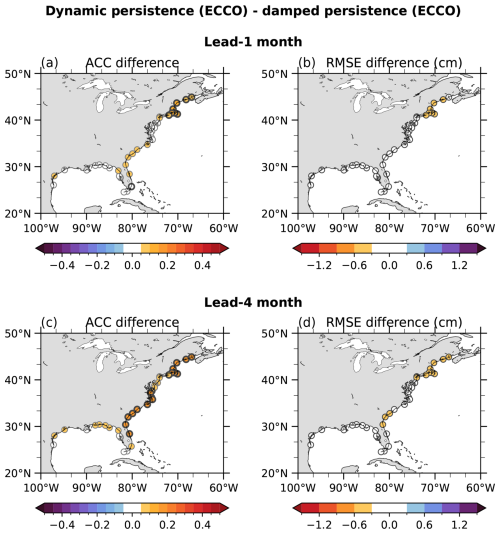
Figure 8Difference in skill (ACC and RMSE) between dynamic persistence (ECCO) and damped persistence (ECCO) at lead-1 (a, b) and lead-4 (c, d) months, with each product being compared to monthly sea level anomalies derived from the ECCO state estimate. Orange shading indicates more skill (higher ACC and lower RMSE) for dynamic persistence (ECCO) compared to damped persistence (ECCO). Circles with thick black outlines denote statistically significant ACC differences at the 0.05 significance level. Note that smaller ACC differences are more likely to pass the significance test in (a) because the respective ACC values of both models are typically closer to 1 at the shorter lead time (e.g., at Virginia Key).
Despite dynamic persistence having the best lead-4 month forecast skill at Charleston, Virginia Key, and Grand Isle, along with most other locations south of Cape Hatteras, we noticed a lack of variability in this model's predicted monthly sea level anomalies. Figures 9 and 10 show the time series of forecasts from each model at the lead-1 and lead-4 months, respectively, compared with water level gauge observations. None of the models depict the observed amounts of coastal sea level variability at either lead. For dynamic persistence at the lead-4 month, the SD values are 2.5 cm at The Battery (observed: 5.7 cm), 1.4 cm at Charleston (observed: 6.7 cm), 1.2 cm at Virginia Key (observed: 5.0 cm), and 1.6 cm at Grand Isle (observed: 5.4 cm). Considering Charleston again for further comparison, variability is only somewhat larger for dynamic persistence at the lead-1 month (2.3 cm); damped persistence similarly suffers from diminished variability, especially by the lead-4 month (0.9 cm; Fig. 10b), and the climate forecast variability is the largest of the models for both the lead-1 and lead-4 months (4.7 and 3.6 cm, respectively). The larger variability of the climate forecast does not translate to better skill at the lead-4 month because that model deviates the most from observations, as evidenced by it having the lowest ACC and highest RMSE values for Charleston (0.08 and 7.3 cm; Fig. 10b), as well as almost everywhere else on the Gulf Coast and East Coast (Fig. 6c and d). Potential causes of the weak variability noticed in dynamic persistence forecasts are discussed in Sect. 4, along with a mention about how this may concern the usability of such predictions.
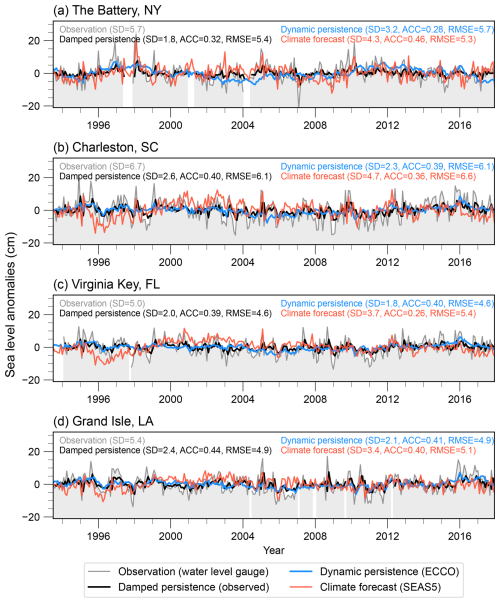
Figure 9Time series of monthly sea level anomalies according to observations from water level gauges and the lead-1 month retrospective forecasts from the damped persistence (observed), dynamic persistence (ECCO), and climate forecast (SEAS5) models. For each example location (labeled in Fig. 1a), the SD (cm), ACC, and RMSE (cm) metrics are indicated for the models and observations (SD only).
This study indicates the potential of using ocean dynamic persistence to improve seasonal sea level forecasts for the US Gulf Coast and East Coast, particularly south of Cape Hatteras. By assessing initialized ocean conditions from the ECCO framework that were run forward dynamically under climatological atmospheric conditions, we showed that dynamic persistence achieves higher forecast skill overall compared to damped persistence. Dynamic persistence also performs similar to or better than the SEAS5 climate forecast nearly everywhere that we assessed. Notably, the dynamic persistence model outperforms the other models at the lead-4 month, with higher ACC values at most locations along the Southeast Coast and Gulf Coast (Fig. 6a). Despite showing minimal improvement in RMSE, dynamic persistence exhibits similar or better skill according to this metric at longer lead times than damped persistence (e.g., at the lead-4 month; Fig. 6b), and both of those models perform better than the much more sophisticated SEAS5 model (Fig. 6d).
Better performance of dynamic persistence compared to damped persistence can be attributed to the ocean's ability to retain the memory of initial conditions, particularly through its high thermal inertia as well as processes such as Rossby waves and horizontal advection, which can influence sea levels over time. This is especially relevant along the Southeast Coast, where delayed oceanic responses to remote forcings are an opportunity to improve forecast skills (Calafat et al., 2018; Frederikse et al., 2022). However, the dynamic persistence forecast only captures seasonally predicable forcings on the ocean, thereby simulating how oceanic initial conditions evolve according to a climatological atmosphere. As a result, sea level variability predicted by dynamic persistence tends to be much weaker compared to what is observed in the real ocean forced by actual atmospheric conditions. The climatological atmospheric forcing used in the dynamic persistence forecast tends to restore the ocean toward a seasonally steady state, while friction and mixing gradually dissipate existing sea level anomalies, resulting in reduced sea level variability over time (Sérazin et al., 2014). ECCO's coarse resolution (nominally 1°) may also contribute to its weak variability at all leads, and there is emerging evidence that much higher resolution (i.e., finer than 0.25°) is probably necessary to resolve sea levels along the Gulf Coast and East Coast well (Feng et al., 2024; Little et al., 2024). Our attempt to scale the dynamic persistence forecast by its SD did not yield better skill according to the RMSE metric.
Differences between dynamic persistence and damped persistence are less pronounced along the Northeast Coast, which is likely due to the relatively poor initial conditions of the former model, as evidenced by the rather low ACC at the lead-0 month for ECCO V4r4 (Fig. 7a). Interestingly, when we compare the dynamic persistence forecast to an experiment using damped persistence of the ECCO state estimate (instead of observations), much higher skills for dynamic persistence are evident along the Northeast Coast at the lead-1 and lead-4 months (Fig. 8), which points to an opportunity to improve initial conditions as a way toward better forecasts. Yet even at The Battery location on the Northeast Coast, dynamic persistence exhibits clearly higher ACC values after the lead-4 month compared to the other models (Fig. 7a), which could be due to the propagation of remote signals improving the skill of dynamic persistence over time (at least compared to damped persistence).
While for short lead times the SEAS5 climate forecast has ACC values comparable with the other models (i.e., at the lead-1 month; Fig. 3e) and for at least several months longer in some open-ocean regions (Fig. 3f), its performance declines rapidly at the coastal locations considered here. The mediocre initial conditions from ORAS5 near the coast (Fig. 2; see also Feng et al., 2024), coupled with the limited predictability of atmospheric variability at seasonal timescales (Lee et al., 2023; Newman et al., 2003), may contribute to SEAS5's lower skill compared to damped persistence and dynamic persistence at the lead-4 month for the Gulf Coast and East Coast (e.g., Fig. 6). The upcoming release of SEAS6, which incorporates data assimilation improvements in coastal areas from the ORAS6 reanalysis (Zuo et al., 2024), may address limitations relating to initial conditions. Plans are also underway to further quantify the role of the ocean observing system in the performance of current subseasonal to seasonal forecasting systems (Fujii et al., 2023), which should help to identify aspects of the coastal environment that are most important to assimilate well. For now, this study suggests that dynamic persistence is an alternative and probably better-performing option, compared to the SEAS5 climate model example, for sea level forecasting on some coasts like the regions we assessed. Despite the coarser resolution of the ECCO framework, dynamic persistence seems to capture essential sources of ocean predictability that SEAS5 struggles with, particularly along the Southeast Coast.
Although dynamic persistence shows promise, application in its current form for operational forecasting such as NOAA's monthly high-tide flooding outlook is hindered by its weak variability, which manifests in an inability to predict extreme sea level events. Furthermore, it remains to be tested whether implementing sea level anomalies from the dynamic persistence forecast will improve the high-tide flooding outlook. It is perceivable that concerns about the utility of dynamic persistence in predicting high-tide flooding could be mitigated by improving the model, such as through better initial conditions (i.e., data assimilation improvements) and more realistic physics (i.e., increasing the resolution). Forecast models could also be made more accurate for predicting the coastal sea levels by including the IB effect (Albers et al., 2025). Nonetheless, utilizing the dynamic persistence of ECCO, or probably other ocean models having realistic initial conditions, would set a higher benchmark than damped persistence and offer a more robust foundation for evaluating the performance of future seasonal forecasting systems. We hope this study encourages further evaluation of dynamic persistence as a new baseline for improving seasonal forecasts of sea levels and potentially other aspects of ocean variability.
Water level gauge observations are provided by NOAA (2025) (https://api.tidesandcurrents.noaa.gov/api/prod/). Altimetry observations are available from the EU Copernicus Marine Service, Marine Data Store at https://doi.org/10.48670/moi-00145 (Copernicus Marine Service, 2018). ORAS5 data are available at the Climate Data Store (https://doi.org/10.24381/cds.67e8eeb7, Copernicus Climate Change Service, 2021). SEAS5 data are available at the Climate Data Store (https://doi.org/10.24381/cds.2f9be611, Copernicus Climate Change Service, 2018). The ECCO state estimate is available at https://podaac.jpl.nasa.gov/ECCO (ECCO Consortium, 2019; Forget et al., 2015). ECCO dynamic persistence experiments are available at https://doi.org/10.5281/zenodo.16707942 (Wang and Lee, 2025).
XF, MW, and TL conceived the study. XF performed the analysis and produced the figures. XF, OW, MB, and HZ contributed to the data curation. XF and MW wrote the original draft. All coauthors reviewed the results and improved the writing.
The contact author has declared that none of the authors has any competing interests.
Publisher's note: Copernicus Publications remains neutral with regard to jurisdictional claims made in the text, published maps, institutional affiliations, or any other geographical representation in this paper. While Copernicus Publications makes every effort to include appropriate place names, the final responsibility lies with the authors.
The authors thank NASA-JPL and ECMWF for making their retrospective forecasts available. A large language model (ChatGPT 4o from OpenAI) was used to clarify the writing on an earlier version of the paper. This is International Pacific Research Center publication 1642 and SOEST contribution 11947.
This study was primarily supported by the NOAA Climate Program Office's Modeling, Analysis, Predictions, and Projections (MAPP) program through grant NA22OAR4310138. Part of this research was carried out at the Jet Propulsion Laboratory, California Institute of Technology, under a contract with the National Aeronautics and Space Administration (80NM0018D0004). Additional support was provided by the NOAA Climate Program Office's Climate Variability and Predictability–Modeling, Analysis, Predictions, and Projections (CVP-MAPP) cross-program through grant NA23OAR4310454.
This paper was edited by Bernadette Sloyan and reviewed by Ryan Holmes and Yingli Zhu.
Albers, J. R., Newman, M., Balmaseda, M. A., Sweet, W., Wang, Y., and Xu, T.: Assessing Subseasonal Forecast Skill for Use in Predicting US Coastal Inundation Risk, EGUsphere [preprint], https://doi.org/10.5194/egusphere-2025-897, 2025.
Balmaseda, M. A., McAdam, R., Masina, S., Mayer, M., Senan, R., de Bosisséson, E., and Gualdi, S.: Skill assessment of seasonal forecasts of ocean variables, Front. Mar. Sci., 11, 1380545, https://doi.org/10.3389/fmars.2024.1380545, 2024.
Calafat, F. M., Wahl, T., Lindsten, F., Williams, J., and Frajka-Williams, E.: Coherent modulation of the sea-level annual cycle in the United States by Atlantic Rossby waves, Nat. Commun., 9, 2571, https://doi.org/10.1038/s41467-018-04898-y, 2018.
Chelton, D. B. and Schlax, M. G.: Global observations of oceanic Rossby Waves, Science, 272, 234–238, https://doi.org/10.13053/CyS-18-3-2043, 1996.
Copernicus Climate Change Service: Seasonal forecast monthly averages of ocean variables, Copernicus Climate Change Service [data set], https://doi.org/10.24381/cds.2f9be611, 2018.
Copernicus Climate Change Service: ORAS5 global ocean reanalysis monthly data from 1958 to present, Copernicus Climate Change Service [data set], https://doi.org/10.24381/cds.67e8eeb7, 2021.
Copernicus Marine Service: Global Ocean Gridded L 4 Sea Surface Heights And Derived Variables Reprocessed, Copernicus Climate Service [data set], https://doi.org/10.48670/moi-00145, 2018.
Dangendorf, S., Hendricks, N., Sun, Q., Klinck, J., Ezer, T., Frederikse, T., Calafat, F. M., Wahl, T., and Törnqvist, T. E.: Acceleration of U.S. Southeast and Gulf coast sea-level rise amplified by internal climate variability, Nat. Commun., 14, 1935, https://doi.org/10.1038/s41467-023-37649-9, 2023.
Deser, C., Alexander, M. A., and Timlin, M. S.: Understanding the persistence of sea surface temperature anomalies in midlatitudes, J. Climate, 16, 57–72, https://doi.org/10.1175/1520-0442(2003)016<0057:UTPOSS>2.0.CO;2, 2003.
Dusek, G., Sweet, W. V., Widlansky, M. J., Thompson, P. R., and Marra, J. J.: A novel statistical approach to predict seasonal high tide flooding, Front. Mar. Sci., 9, 1073792, https://doi.org/10.3389/fmars.2022.1073792, 2022.
ECCO Consortium, Fukumori, I., Wang, O., Fenty, I., Forget, G., Heimbach, P., and Ponte, R. M.: ECCO Central Estimate (Version 4 Release 4), NASA [data set], https://podaac.jpl.nasa.gov/ECCO (last access: April 2024), 2019.
Feng, X., Widlansky, M. J., Balmaseda, M. A., Zuo, H., Spillman, C. M., Smith, G., Long, X., Thompson, P., Kumar, A., Dusek, G., and Sweet, W.: Improved capabilities of global ocean reanalyses for analysing sea level variability near the Atlantic and Gulf of Mexico Coastal U.S., Front. Mar. Sci., 11, 1–21, https://doi.org/10.3389/fmars.2024.1338626, 2024.
Forget, G., Campin, J. M., Heimbach, P., Hill, C. N., Ponte, R. M., and Wunsch, C.: ECCO version 4: An integrated framework for non-linear inverse modeling and global ocean state estimation, Geosci. Model Dev., 8, 3071–3104, https://doi.org/10.5194/gmd-8-3071-2015, 2015.
Frankignoul, C. and Hasselmann, K.: Stochastic climate models, Part I Application to sea-surface temperature anomalies and thermocline variability, Tellus, 29, 289–305, https://doi.org/10.1111/j.2153-3490.1977.tb00740.x, 1977.
Frederikse, T., Simon, K., Katsman, C. A., and Riva, R.: The sea-level budget along the Northwest Atlantic coast: GIA, mass changes, and large-scale ocean dynamics, J. Geophys. Res.-Oceans, 122, 5486–5501, https://doi.org/10.1002/2017JC012699, 2017.
Frederikse, T., Lee, T., Wang, O., Kirtman, B., Becker, E., Hamlington, B., Limonadi, D., and Waliser, D.: A Hybrid Dynamical Approach for Seasonal Prediction of Sea-Level Anomalies: A Pilot Study for Charleston, South Carolina, J. Geophys. Res.-Oceans, 127, e2021JC018137, https://doi.org/10.1029/2021JC018137, 2022.
Fujii, Y., Balmaseda, M., and Remy, E.: SynObs Flagship OSEs Guideline Version 1, OceanPredict website, https://oceanpredict.org/docs/Documents/SynObs/SynObs_FlagshipOSE_Guideline_Ver1.pdf (last access: 8 January 2025), 2023.
Hasselmann, K.: Stochastic climate models Part I. Theory, Tellus, 28, 473–485, https://doi.org/10.1111/j.2153-3490.1976.tb00696.x, 1976.
Hersbach, H., Bell, B., Berrisford, P., Biavati, G., Horányi, A., Muñoz Sabater, J., Nicolas, J., Peubey, C., Radu, R., Rozum, I., Schepers, D., Simmons, A., Soci, C., Dee, D., and Thépaut, J.-N.: ERA5 monthly averaged data on single levels from 1940 to present, Copernicus Climate Change Service (C3S) Climate Data Store (CDS) [data set], https://doi.org/10.24381/cds.f17050d7, 2023.
Johnson, S. J., Stockdale, T. N., Ferranti, L., Balmaseda, M. A., Molteni, F., Magnusson, L., Tietsche, S., Decremer, D., Weisheimer, A., Balsamo, G., Keeley, S. P. E., Mogensen, K., Zuo, H., and Monge-Sanz, B. M.: SEAS5: the new ECMWF seasonal forecast system, Geosci. Model Dev., 12, 1087–1117, https://doi.org/10.5194/gmd-12-1087-2019, 2019.
Lee, C. C., Sheridan, S. C., Dusek, G. P., and Pirhalla, D. E.: Atmospheric Pattern-Based Predictions of S2S Sea Level Anomalies for Two Selected U.S. Locations, Artific. Intel. Earth Syst., 2, 220057, https://doi.org/10.1175/AIES-D-22-0057.1, 2023.
Little, C. M., Yeager, S. G., Ponte, R. M., Chang, P., and Kim, W. M.: Influence of Ocean Model Horizontal Resolution on the Representation of Global Annual-To-Multidecadal Coastal Sea Level Variability, J. Geophys. Res.-Oceans, 129, e2024JC021679, https://doi.org/10.1029/2024JC021679, 2024.
Long, X., Widlansky, M. J., Spillman, C. M., Kumar, A., Balmaseda, M., Thompson, P. R., Chikamoto, Y., Smith, G. A., Huang, B., Shin, C. S., Merrifield, M. A., Sweet, W. V., Leuliette, E., Annamalai, H. S., Marra, J. J., and Mitchum, G.: Seasonal Forecasting Skill of Sea-Level Anomalies in a Multi-Model Prediction Framework, J. Geophys. Res.-Oceans, 126, e2020JC017060, https://doi.org/10.1029/2020JC017060, 2021.
Long, X., Newman, M., Shin, S.-I., Balmeseda, M., Callahan, J., Dusek, G., Jia, L., Kirtman, B., Krasting, J., Lee, C. C., Lee, T., Sweet, W., Wang, O., Wang, Y., and Widlansky, M. J.: Evaluating Current Statistical and Dynamical Forecasting Techniques for Seasonal Coastal Sea Level Prediction, J. Climate, 38, 1477–1503, https://doi.org/10.1175/JCLI-D-24-0214.1, 2025.
Meehl, G. A., Richter, J. H., Teng, H., Capotondi, A., Cobb, K., Doblas-Reyes, F., Donat, M. G., England, M. H., Fyfe, J. C., Han, W., Kim, H., Kirtman, B. P., Kushnir, Y., Lovenduski, N. S., Mann, M. E., Merryfield, W. J., Nieves, V., Pegion, K., Rosenbloom, N., Sanchez, S. C., Scaife, A. A., Smith, D., Subramanian, A. C., Sun, L., Thompson, D., Ummenhofer, C. C., and Xie, S.-P.: Initialized Earth System prediction from subseasonal to decadal timescales, Nat. Rev. Earth Environ., 2, 340–357, https://doi.org/10.1038/s43017-021-00155-x, 2021.
Minobe, S., Terada, M., Qiu, B., and Schneider, N.: Western boundary sea level: A theory, rule of thumb, and application to climate models, J. Phys. Oceanogr., 47, 957–977, https://doi.org/10.1175/JPO-D-16-0144.1, 2017.
Newman, M., Sardeshmukh, P. D., Winkler, C. R., and Whitaker, J. S.: A Study of Subseasonal Predictability, Mon. Weather Rev., 131, 1715–1732, https://doi.org/10.1175//2558.1, 2003.
NOAA: Hourly tide gauge data [data set], National Oceanic and Atmospheric Administration [data set], https://api.tidesandcurrents.noaa.gov/api/prod/ (last access: 30 July 2025), 2025.
Obarein, O. A., Lee, C. C., Smith, E. T., and Sheridan, S. C.: Evaluating Medium-Range Forecast Performance of Regional-Scale Circulation Patterns, Weather Forecast., 38, 1467–1480, https://doi.org/10.1175/WAF-D-22-0149.1, 2023.
Roberts, C. D., Vitart, F., and Balmaseda, M. A.: Hemispheric Impact of North Atlantic SSTs in Subseasonal Forecasts, Geophys. Res. Lett., 48, e2020GL0911446, https://doi.org/10.1029/2020GL091446, 2021.
Sérazin, G., Penduff, T., Grégorio, S., Barnier, B., Molines, J.-M., and Terray, L.: Intrinsic Variability of Sea Level from Global Ocean Simulations: Spatiotemporal Scales, J. Climate, 28, 4279–4292, https://doi.org/10.1175/jcli-d-14-00554.1, 2014.
Shi, H., Jin, F.-F., Wills, R. C. J., Jacox, M. G., Amaya, D. J., Black, B. A., Rykaczewski, R. R., Bograd, S. J., García-Reyes, M., and Sydeman, W. J.: Global decline in ocean memory over the 21st century, Sci. Adv., 8, eabm3468, https://doi.org/10.1126/sciadv.abm3468, 2022.
Wang, O. and Lee, T.: Monthly Mean Sea Surface Height from Dynamic Persistence Forecasts Based on ECCO Version 4 Release 4 (V4r4) (1.0), Zenodo [data set], https://doi.org/10.5281/zenodo.16707942, 2025.
Wang, O., Lee, T., Piecuch, C. G., Fukumori, I., Fenty, I., Frederikse, T., Menemenlis, D., Ponte, R. M., and Zhang, H.: Local and Remote Forcing of Interannual Sea-Level Variability at Nantucket Island, J. Geophys. Res.-Oceans, 127, e2021JC018275, https://doi.org/10.1029/2021JC018275, 2022.
Wang, O., Lee, T., Frederikse, T., Ponte, R. M., Fenty, I., Fukumori, I., and Hamlington, B. D.: What Forcing Mechanisms Affect the Interannual Sea Level Co-Variability Between the Northeast and Southeast Coasts of the United States?, J. Geophys. Res.-Oceans, 129, e2023JC019873, https://doi.org/10.1029/2023JC019873, 2024.
Widlansky, M. J., Marra, J. J., Chowdhury, M. R., Stephens, S. A., Miles, E. R., Fauchereau, N., Spillman, C. M., Smith, G., Beard, G., and Wells, J.: Multimodel ensemble sea level forecasts for tropical Pacific Islands, J. Appl. Meteorol. Clim., 56, 849–862, https://doi.org/10.1175/JAMC-D-16-0284.1, 2017.
Widlansky, M. J., Long, X., Balmaseda, M. A., Spillman, C. M., Smith, G., Zuo, H., Yin, Y., Alves, O., and Kumar, A.: Quantifying the Benefits of Altimetry Assimilation in Seasonal Forecasts of the Upper Ocean, J. Geophys. Res.-Oceans, 128, e2022JC019342, https://doi.org/10.1029/2022JC019342, 2023.
Zhu, Y., Han, W., Alexander, M. A., and Shin, S.-I.: Interannual Sea Level Variability along the U.S. East Coast during the Satellite Altimetry Era: Local versus Remote Forcing, J. Climate, 37, 21–39, https://doi.org/10.1175/JCLI-D-23-0065.1, 2024.
Zuo, H., Balmaseda, M. A., Tietsche, S., Mogensen, K., and Mayer, M.: The ECMWF operational ensemble reanalysis–analysis system for ocean and sea ice: a description of the system and assessment, Ocean Sci., 15, 779–808, https://doi.org/10.5194/os-15-779-2019, 2019.
Zuo, H., Balmaseda, M. A., de Boisseson, E., Browne, P., Chrust, M., Keeley, S., Mogensen, K., Pelletier, C., de Rosnay, P., and Takakura, T.: ECMWF's next ensemble reanalysis system for ocean and sea ice: ORAS6, ECMWF Newsletter, 30–36, https://doi.org/10.21957/hzd5y821lk, 2024.





